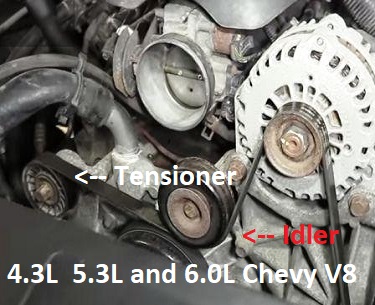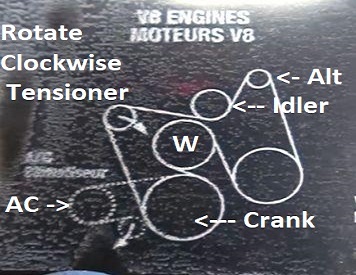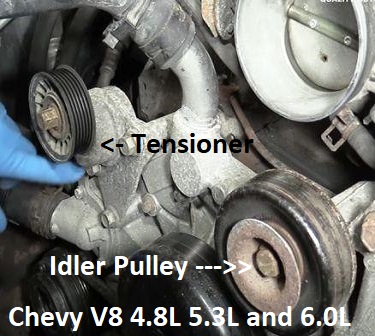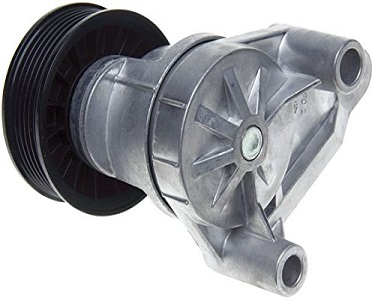Chevrolet V8 Belt Tensioner
Failure of the Chevrolet V8 belt tensioner remains a common problem. Although you can find a bad tensioner on almost any Chevrolet V8 model this page highlights issues on the 4.8L 5.3L and 6.0L V-8 engines.
You can find these power plants in millions of GMC, Cadillac and Chevrolet trucks from the 2000 model year through the 2006 model year.
The originally installed GM part number 12609719 fails in high numbers. Note that replacement parts available from AC Delco can carry an updated part number.
Quick Links: New GM Genuine Parts 12609719 Drive Belt Tensioner.
Chevrolet A/C Serpentine Drive Belt Tensioner Kit. Compatible with
1999-2008 Chevrolet Avalanche, Silverado, Express and GMC
Sierra. Includes new belt.
With that said, it is quite possible to have symptoms of a belt tensioner issue that turns out to be something completely different.
We will we cover how to diagnose and replace a defective Chevrolet V8 belt tensioner. Plus, we'll talk about how to verify that this is the real problem.
The common symptoms of belt squeal, groaning noise, grinding and squeaking can come from other failed components driven by the same serpentine drive belt. If we take our time and apply some logic and positively identify the root cause of the issue.
 Chevrolet V8 Serpentine Belt Tensioner
Chevrolet V8 Serpentine Belt TensionerDiagnosing Bad Belt Tensioners
Squealing or squeaking remains two of the most common symptoms of a defective serpentine belt tensioner.
As far as what goes wrong with the part, there can also be a couple of different failures within this one component. The pulley attached to the spring arm has a bearing on it.
This bearing can fail and cause a squeaking sound that would drive you crazy. The noise that the bearing makes often changes with the engine RPM, but not always.
The other issue that these parts have is a weakening of the tension spring. This allows slack in the belt and the noise you actually hear is caused by slipping over the accessory pulleys.
Finally, another issue that I've seen quite often with this particular GM part number 12609719 is separation of the base and arm assembly. You can see this condition when you rotate the tensioner in the counterclockwise direction.
As you take the weight off of the serpentine drive belt you can see movement between the base that attaches to the engine and the spring arm that applies tension to the belt.
Diagnosing Idler Pulley Problems
 Belt Diagram 4.8L 5.3L and 6.0L Engines
Belt Diagram 4.8L 5.3L and 6.0L EnginesExcessive movement in this area indicates a failed Chevrolet V8 belt tensioner. The idler pulley fails in far fewer numbers than the tensioner.
This is because the idler pulley doesn't move around and becomes subjected to less vibration and wear. However, this part might also need replacing at the same time that the belt tensioner fails.
You find this scenerio more often on high mileage 4.8L 5.3L and 6.0L V8 engines. So here's how you diagnose a bad idler pulley.
With the belt removed you can check for play in the bearing. There should be absolutely no end play or deflection as you wiggle the hub of the pulley.
In addition, you can spin the idler pulley and it should free spin easily. If it doesn't keep going for a second or two I would go ahead and replace it.
Also you can grab the pulley hub and rotate it and verify smooth operation. Any gritty or bumpy feeling as you rotate becomes another indication that this part needs replacing.
I've seen a lot of owners complain about having to replace parts on this engine. Things like water pumps, alternators and idler pulleys weren't designed to go 300,000 miles. Although none of us like replacing these parts it’s pretty amazing that you can put this many miles on these motors.
What Else Causes Serpentine Belt Noise
It's important to note that any serpentine belt driven accessory can make noise that sounds an awful lot like a defective tensioner or idler pulley.
Each of these components has their own bearings that can make the same squeaking, squealing, grinding or rumbling noises. Let's use the vehicle air conditioning system compressor as an example.
Although this component can produce noise at various speeds the sound often worsens when the compressor is engaged.
When the AC compressor is the cause of belt noise the sound always changes when the compressor cycles on and off. When an alternator bearing fails, it may not show any signs of automotive electrical system problems.
To properly diagnose a failed alternator bearing you remove the belt and rotate the pulley on the alternator by hand. Just like when diagnosing the idler pulley there should be no play or noise.
It should also rotate smoothly with no roughness felt. Finally, an old serpentine drive belt or one of poor quality can also generate squealing and squeaking sounds.
You can condemn the rubber belt by eliminating all of the other possibilities. However, there is another method you can use that provides a strong indication that the belt needs replacing.
You can take a high-volume spray bottle containing clean tap water and wet the belt down. If the noise disappears completely it could be an indication that a new belt will fix the problem.
With that said, using a belt dressing or any type of oil based product is not recommended. These spray lubricants actually begin to eat away at the rubber quickly.
Replacing the Chevrolet V8 Belt Tensioner
 Chevy V8 Belt Tensioner and Idler Pulley
Chevy V8 Belt Tensioner and Idler PulleyTo gain access to the part you must remove the air intake runner assembly. With this plastic thing swung out of the way you'll have plenty of room to compress the tensioner spring by rotating it in the clockwise direction.
Sidebar: although the center bolt is only a 15 mm in size it takes quite a bit of force to rotate the tensioner.
You'll most likely need something longer than a standard wrench. I use a serpentine belt tool, but you can also use a long handle breaker bar or extra long handle ratchet.
One of the obvious tips when you go to replace the Chevrolet V8 belt tensioner is to remember where the short bolt goes.
Two of the bolts go through the tensioner assembly and the water pump. The remaining short bolt threads into the engine bracket assembly.
The two longer bolts install in the upper holes and the short bolt threads into the lowest position. Here's the important point to make.
For some reason people like to crush these bolts when tightening them down. The official torque specification provided in the General Motors repair manual comes in at 37 foot-pounds.
I highly recommend using a torque wrench to tighten these bolts. Over tightening and stripping the retaining bolts remain two of the most common problems associated with DIY maintenance replacement of the Chevrolet V8 belt tensioner.
Final Thoughts about Servicing the Belt Tensioner
 Chevrolet Belt Tension Assembly
Chevrolet Belt Tension AssemblyMy long-standing customers know that I'm not the kind of mechanic that likes to up sell a simple small repair into a big expensive job.
However, when you're in there replacing the tensioner you might consider replacing the idler pulley and getting yourself a new high quality replacement serpentine belt at the same time.
My next recommendation goes out to people who consider this vehicle their forever truck. When some of my customers buy a Chevrolet truck they plan to keep it in the family for a long time.
They might hand it down to a young driver or keep it around as a work truck. For this reason you might consider replacing the water pump at the same time.
The original equipment water pumps on these trucks last for about 10 years or 150,000 miles. Of course, your results might vary.
With that said, if you have a 2006 Chevrolet Silverado with the 4.8L 5.3L or 6.0L engine, your vehicle is already past these milestones. This means your water pump is running on borrowed time.
My final thought about the Chevrolet V-8 belt tensioner points back to an alternative diagnostic method. Professional technicians own a noise finding device known as the mechanics stethoscope.
This can make quick work of diagnosing all kinds of engine noises. In the case of a failed accessory pulley bearing the mechanics stethoscope becomes a valuable special tool.
When you place the tip of the probe on a healthy bearing it sounds delightful and smooth. However, when you place the probe against a bearing in the process of failing it makes a racket.
The tool can prevent you from misdiagnosing these hard to decipher serpentine belt noises. We filed this post in the miscellaneous automotive problems section. If you own one of these Chevy trucks, you should learn about the common Vortec V8 coolant leak from the intake manifold.
Author bio : Mark is a retired ASE certified master technician, Chevrolet Professional Service Council member and the founder of FixMyOldRide.com. Watch the video on the about Mark the mechanic page to see his credentials. Mark hand writes all of the articles on FixMyOldRide.com unless indicated otherwise.